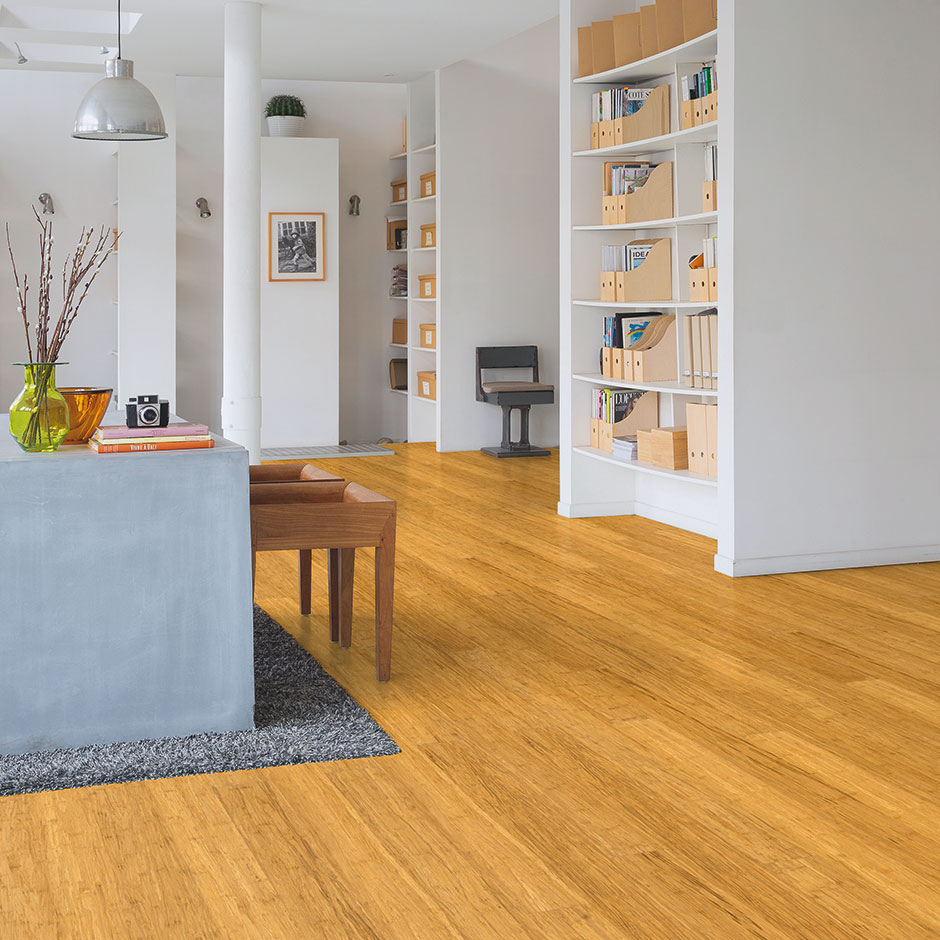Last updated 30/1/2024
Bamboo flooring has gained much attention since its introduction to the flooring world. Although bamboo is typically referred to as timber or hardwood flooring, it is actually a type of grass that gets processed into a variety of flooring and home products.
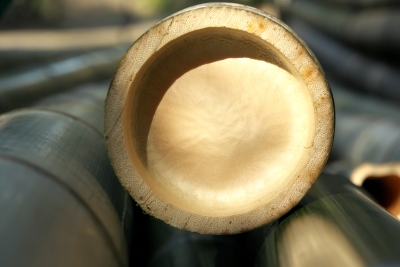
A close-up of mosmo bamboo used to make bamboo flooring.
Since it behaves much like timber, bamboo flooring has benefits and drawbacks similar to wood flooring.
In this blog post, we will discuss bamboo flooring as a product in Australia, types of bamboo flooring, pros & cons, history, product development and whether this flooring is right for your home.
What are Bamboo Floors?
Bamboo flooring today is all made using the ‘Strand Woven’ construction method, which greatly increases the strength, stability and density of the product over the earlier variants that have gone before. Regardless of whether the product is solid, engineered of a micro veneer SPC Bamboo, each variant is made as a strand woven product.
- Strand woven bamboo is created by first shaving the bamboo staves into thin layers.
- These layers are then dipped in an adhesive and allowed to dry.
- Once they dry, they are loaded into a mould and pressed under enormous heat and pressure.
- This dramatically increases the strength and density of the product over its natural form.
Bamboo flooring is retailed in two main categories:
Solid Bamboo
This style of bamboo will probably never disappear completely. There is something satisfying about picking up a plank of solid bamboo flooring and feeling the weight of it against engineered flooring.
While there is a certain feel-good factor to this, engineered flooring exists to reduce the amount of growth and shrinkage in the product to help stabilise it in large rafts.
This is the strongest form of bamboo flooring; however, as with downward impacts, the entire system must be considered, not just the top veneer. This makes solid bamboo one of the most durable products on the market.
Engineered Bamboo
Engineered bamboo flooring follows the same principle as engineered timber by having a thinner top veneer (usually 3 mm) of bamboo bonded to a plywood core. Studies show that growth and shrinkage are reduced by around 30% when bamboo is made as engineered flooring versus its solid equivalent.
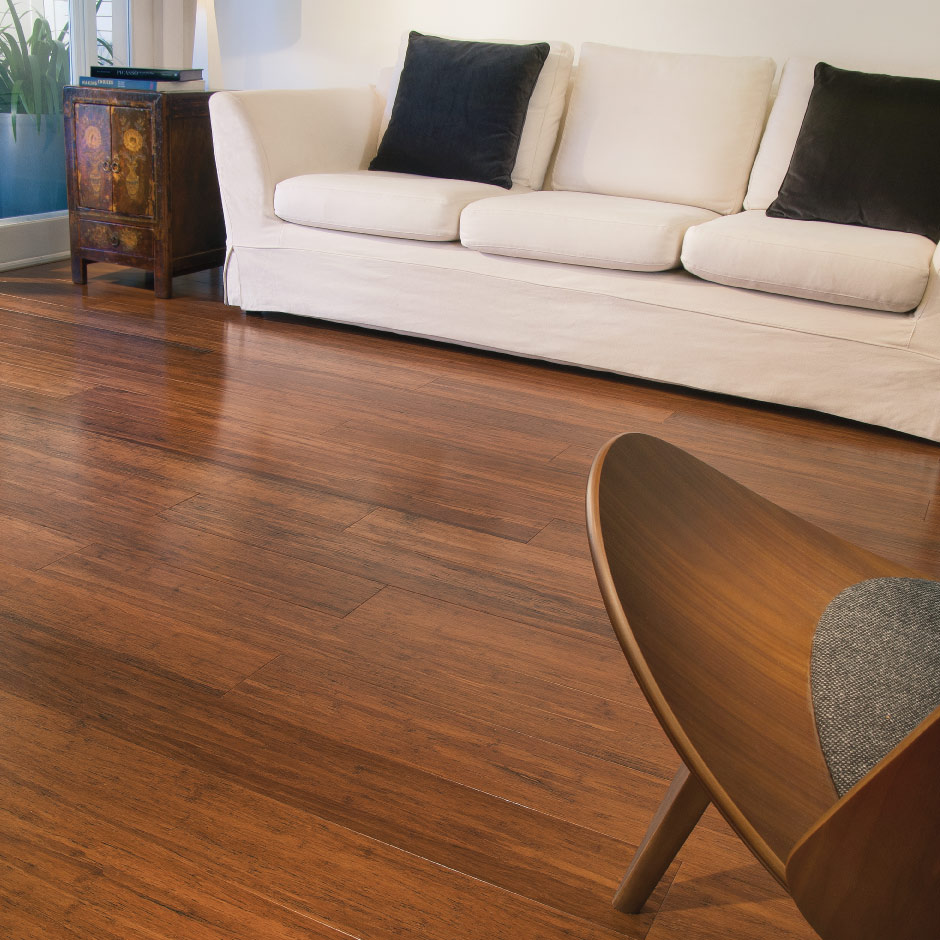
Engineered bamboo floors don’t tend to grow or shrink as much as their solid counterparts.
You might think a 3 mm veneer would equal a great price reduction against a 14 mm solid product, but this is not true. The process of manufacturing an engineered bamboo floor is much greater than that of a solid one as there are more stages to the process, making it more labour-intensive.
This translates to an increased raft sizing before the floor requires expansion breaks and has even led to 180 mm wide bamboo flooring. Previously, this was something that only the bravest dared to attempt in solid bamboo, and it failed spectacularly! The additional stability of engineered bamboo flooring makes this a reality now.
However, against downward impacts, this will not perform as well as Solid Bamboo. While a 3mm layover of strand woven bamboo is very strong, the ply core beneath it is softer, making the system less resistant to impacts than it’s solid counterpart.
Micro Veneer SPC Bamboo
Possibly the most exciting development in flooring is micro veneer SPC core products. These flooring products use the same SPC core that is in hybrid flooring, but have a 0.6 mm micro veneer of timber or bamboo on the surface.
Essentially, this gives you the visual of a natural floor in that you will never, ever have a repeat pattern in the floor while also giving the benefits of the waterproof SPC core.
The theory here is the same as a micro Veneer on a ply core: the veneer is so thin that it does not have enough lateral strength to exert sufficient force on the core to deform the plank. The core, and not the veneer, becomes the strongest layer of the product, increasing its stability many fold.
Because of this, SPC core bamboo allows for much larger raft sizes than even engineered bamboo. Additionally, because the veneer is so thin, the polyurethane coats and completely penetrates the wood, making it waterproof. However, because this is the newest incarnation of bamboo flooring, it is yet to be tested in the market truly.
This kind of bamboo is worst in the downward impact scale. Firstly, the veneer itself is thin, roughly the thickness of a sheet of paper. Adding to this is that the SPC core beneath is much softer compared to the bamboo itself. It is not to say that it is bad at all, as SPC flooring performs very well. It is just that solid-strand woven bamboo is so incredibly strong.
Bamboo vs. Hardwood Flooring
With so many similarities, choosing between bamboo and hardwood flooring can be difficult. Bamboo typically features more consistent colours than most hardwoods. Although there is just as much variation between bamboo strands as they are all pushed together, it creates a more uniform overall look. Hardwood is what hardwood is, and varies from piece to piece.
Both materials require a certain amount of care against water, although bamboo is slightly more resistant to water damage than timber. Like other hardwood flooring, bamboo may be refinished, depending on the thickness of the planks.
Top-quality bamboo flooring is as durable as the hardest species of traditional hardwood flooring, but both are somewhat susceptible to scratches. As with any product, not all bamboo flooring is created equal. Look for flooring with a substantial warranty.
Finally, bamboo is considered the more sustainable resource of the two since it is harvested from living shoots that will regrow.
Bamboo Flooring Pros
Now that the market has equalised, bamboo can be a terrific flooring option. For those who prefer modern décor, bamboo flooring has a clean, contemporary look and can be an excellent choice of flooring material, with positive aspects including:
- Properly finished bamboo flooring cleans easily with a mop and mild soap
- Possibility of being refinished, depending on the thickness of the planks
- A sustainable resource, easily replenished
- DIY-friendly
- It will add to a home’s value
Bamboo Flooring Cons
Cons of bamboo flooring include:
- It can be susceptible to scratches (especially inexpensive, low-quality versions)
- Bamboo can expand and contract up to 60% more than engineered timber.
- Bamboo’s contemporary look may not suit all décor
- It has recently become limited to a few natural shades
Cheaply sourced brands may contain toxins and VOCs (avoid this by choosing brands certified by the Forestry Stewardship Council (FSC)
Responsibly and Sustainably
In Australia, importing any timber or bamboo flooring that does not meet strict Forestry Stewardship Criteria is illegal. This is shown on product boxes bearing the FSC logo.
This logo means the product is logged responsibly from sustainable forests that replenish themselves faster than timber can! It also indicates that a product is free of the harmful toxins and VOCs that can be found in brands shipped from overseas.
Bamboo is also a fast-growing plant available in vast quantities, making it a rapidly renewable resource. Utilising bamboo also takes some of the pressure off of other species of wood.
When Were Bamboo Floors Introduced?
Bamboo flooring first entered the flooring market in its earliest forms over 20 years ago through a small importer named Earth Bamboo. In this early incarnation, the product was expensive, soft, had limited choice, and was very unstable!
The choice was limited in these early days to two colours:
- Coffee (carbonised)
- Natural
These names were to stay with all of the importers who came later, as Earth Bamboo had created names that flooring salespeople had become accustomed to.
In addition to coffee and natural, both colours came in gloss and semi-gloss, expanding the range to four options. But to double this again, there was an option of ‘vertical’ or ‘horizontal’ construction, expanding the bamboo enthusiast’s bank of choice to eight options.
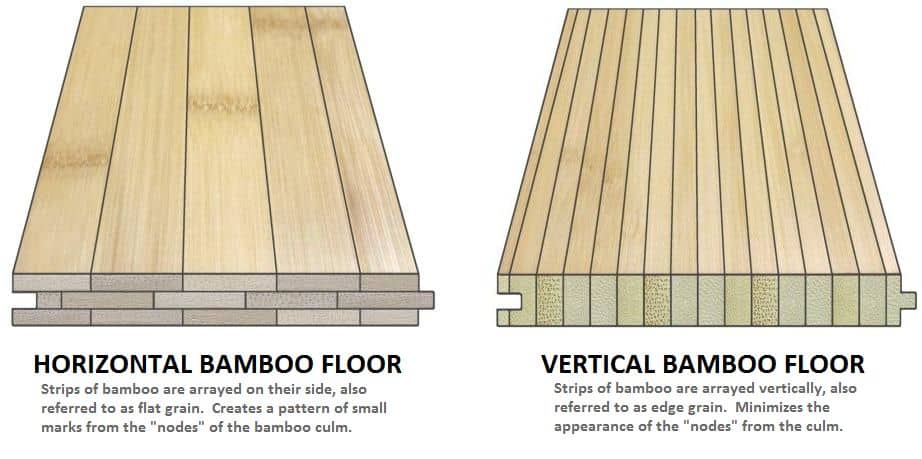
Vertical vs horizontal bamboo flooring (Source: https://www.ambientbp.com).
This early product looked beautiful on the floor. It used a tongue and groove glue-together installation method (like all floating floors at this time) and was sometimes directly stuck to the floor. This proved to be a huge mistake.
Suppliers realised too late that bamboo grows and contracts as much as 2.5 times the amount of an engineered timber floor in its later incarnation. In the early days it was even more!
This made the boards unstable and prone to splitting. Additionally, compared to Australian species hardwoods, it was quite soft, weighing in at only 7 on the Janka Scale. This was still higher than oak, but due to the flat surface of the early bamboo, every sign of passage was shown, and this floor could be quite unforgiving.
However, if the floor was properly acclimated prior to installation, and growth (or shrinkage) was adequately planned for, the floor could be successfully laid. In fact, many of these old bamboo floors still exist today. Then came the invention of strand-woven bamboo, and the game changed!
Strand-Woven Enters the Mainstream
Strand weaving was a different practice to the horizontal and vertical methods:
- Instead of being formed from bamboo rods that were essentially just glued together, woven bamboo was sliced into strands.
- These strands were then dipped in adhesive and left to dry.
- They were then placed into a mould, which was heated and pressed, placing the bamboo under enormous pressure while activating the adhesive.
This greatly increased the density and hardness of the bamboo, more than doubling its Janka rating, making it harder than timbers like Ironbark!
Two methods of bamboo pressing were to emerge, and there was a hotly contested battle as to which was better. Both would face issues but were also prolific in their sales, meaning the story you heard depended upon what type of bamboo a supplier imported.
Cold Pressing
The first strand woven method of bamboo manufacturing was called ‘cold pressing’.
- With this method, the strands of bamboo were loaded into a mould about 150 x 150 mm in width and height.
- This mould was then heated slowly to ‘cook’ the bamboo through to the centre of this block.
Around this time, locking systems became available for hard flooring, and this is where bamboo flooring saw the first explosion and became mainstream.
Cold pressing was much denser than the old vertical and horizontal methods, with a Janka rating of around 15. Using bamboo strands that were forced back together under great pressure increased the density, meaning the product had a greater weight per cubic metre than its predecessors.
The locking system enabled the floor to be laid faster (and therefore cheaper) than earlier variants, making it extremely popular with installers. This meant that many manufacturers entered the Asian market, eager to sell to Australian importers.
Soon, larger importers discovered bamboo and imported it in huge volumes. Poor old Earth Bamboo — who had blazed the trail for bamboo — was soon run over by huge importers and left in their wake. Cold-pressed strand woven bamboo dropped in price as these huge companies entered the market, making bamboo seem like a better value proposition than engineered timber.
The sales story was, “Why would you only want a 4 mm veneer of the timber when you can have a solid 14 mm board? I mean, feel the weight of that…”.
This pitch was true… to a point. It skipped over many of the important issues regarding why we make engineered timber flooring. The story created a life of its own, and soon, the beast was out of the cage. Sales skyrocketed, and proud timber houses, who had tried to fight the new insurgent, soon joined the rebellion as bamboo flooring pummelled their sales.
Cracks did start to appear in the armour as the demand for bamboo soared. High demand and the sometimes subpar practices of manufacture meant that many improperly cured (cooked) products were entering the market.
Because cold-pressed bamboo was formed in the 150 x 150 mm blocks, these blocks were not always evenly dried. Imagine a brown steak on the outside and pink on the middle.
This happened to bamboo, meaning the boards on the outside of the blocks had a lower moisture content, and the boards’ centre from the blocks’ centre was higher. This could make for a very unstable product prone to splitting through the centre of the plank.
Hot Pressing
To cure this problem, a new method of strand weaving, known as ‘hot pressing’, was invented:
- Like cold-pressed bamboo, the bamboo strands were loaded into a mould, but this mould was shaped differently, roughly the width and length of a queen-sized bed and just over 30 mm thick.
- This allowed more bamboo to be loaded into the mould to create a product with greater density.
- Additionally, because the mould was much thinner, the ‘cooking’ time was greatly reduced from over half a day to under an hour! The bamboo went into a hot mould, hence the term hot pressing.
Where cold pressing slowly heated the mould to cook the product through to the centre evenly, hot pressing was like flash frying. Instead of a nice tender steak, you got a piece of shoe leather.
However, this has many benefits as you walk on flooring and don’t eat it. When this ‘sheet’ was removed from the mould, it was cut evenly down the centre and opened to create two sheets about 15 mm thick. These sheets were then sliced into boards and profiled.
The product was denser and more stable than cold-pressed bamboo. It had a greater density, and due to the mould’s shape, more pressure could be placed upon it, making it harder. Hot-pressed bamboo exceeded 16 on the Janke Scale. Hot pressing took the lead in the war between hot and cold-pressed bamboo.
However, hot-pressed bamboo had an issue of its own. Because it was flash-fried and not cooked gently (or so to speak), the colour of hot-pressed bamboo fluctuated dramatically, often very different from the sampling from which the end consumer purchased. Ultimately, the hot-pressed method was less prone to structurally related issues and proved more stable.
Both kinds of bamboo were very successful. The value proposition of a solid floor, as opposed to an engineered one, was a story that caught the consumer’s attention. Additionally, bamboo was only about 60% of the cost of engineered timber.
Problems and the Fall of Bamboo Flooring
This was not a complete success story, though. As with all product categories, technology and competition in the market produced better and less expensive options.
Around 2012, bamboo started to hit its stride. By 2015, all of the major importers of timber flooring decided to stop discrediting the product and jump on the bamboo bandwagon.
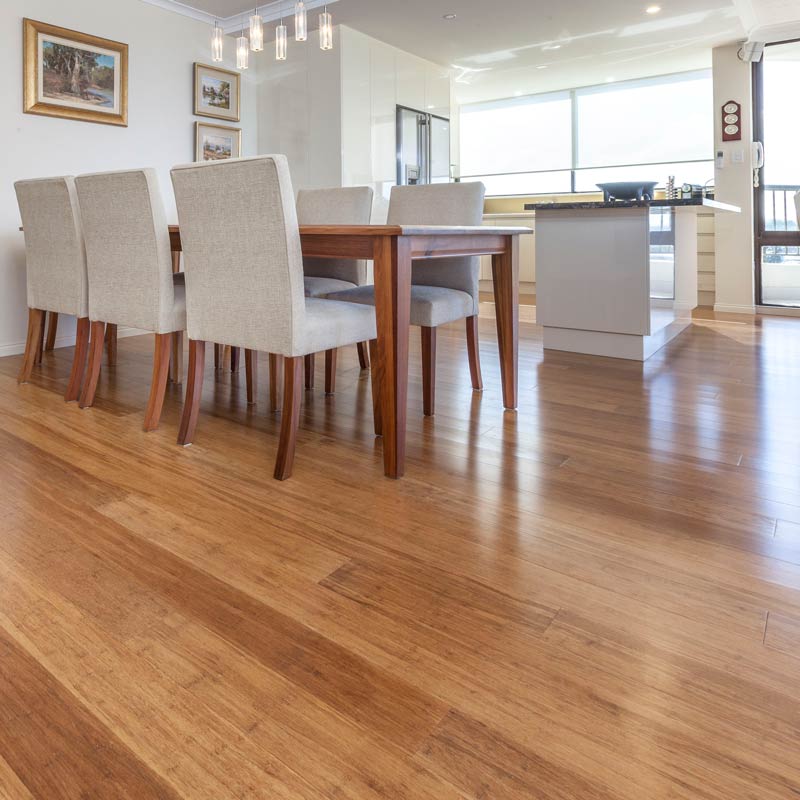
By 2015, bamboo flooring became the first choice for many Australian homeowners.
As more players entered the market, the price kept dropping, and consumers were spoiled for choice. Bamboo sales were prolific, with every major supplier of hard flooring entering the category, along with many second and third-tier companies.
As happens when a product gains success, all and sundry enter the category, leading to cheaper products getting imported (and they are ALWAYS cheaper for a reason).
By 2016, bamboo had become a villain in the marketplace, and sales were tanking.
Frontline salespeople, often under pressure to achieve sales targets, either omitted or were unaware that bamboo is not timber and will grow up to 2 ½ times more than the engineered timber floor they were selling against.
Acclimation was rarely mentioned to the consumer, and often, when a consumer was told of this process, they were unwilling to wait for the product to acclimate or to accept expansion joints in the floor.
As a result, complaints of bamboo skyrocketed, and online reviews eroded confidence in the product category. Within a couple of years, suppliers minimised their bamboo collections, with many flooring stores pulling bamboo from the shelves entirely or relegating it to a small handful of placements, usually in the back corner somewhere.
Fortunately, in the last couple of years, some rather interesting developments in bamboo flooring have greatly enhanced the stability and overall performance of the product. And once again, it is regaining its popularity.
Is Bamboo Flooring Right for You?
This is a question that only you can answer. Bamboo floors look amazing, and due to how they are manufactured, they never have nested (short) boards in the way that timber floors do. Every board you pull out of the box is the full length of the box.
It is a natural, sustainable product that is eco-friendly. If you are worried about VOC’s (volatile organic compounds,) bamboo flooring for a long time carried a low E1 rating, but now many suppliers are claiming E0. It is hard, durable, and will increase the value of a house.
Bamboo failure in the past can be attributed to misinformation and bad installation practices. Unfortunately, being a flooring salesperson requires no particular knowledge or training to enter the industry, and as a result, the industry tends to be over-represented and rather under-skilled.
As a result, product categories like laminate, bamboo, and recently LVT flooring have all had periods of being oversold with no consideration as to whether they were the right product for the consumer’s home. In 99% of cases, simply by following best practices and manufacturers’ instructions, problems are avoided, and your flooring will be installed properly.
Final Thoughts
If you would like to explore Bamboo Flooring but are unsure whether it is the right choice for you, feel free to contact us and learn more. Our team of experts will ask you which design style you prefer, what room the flooring will be installed in, and how much traffic your home gets to help determine the flooring material that best fits your style, budget, and needs.
Our passion lies in helping our customers find flooring they will love for years and years to come. Whether you have one room or an entire house, are just beginning the research process, or have a good idea of what you are looking for, we would be honoured to help you find the best flooring material.


